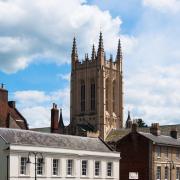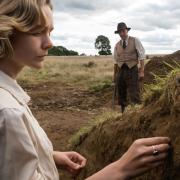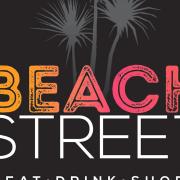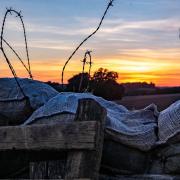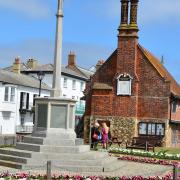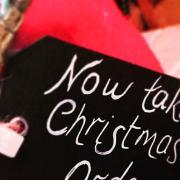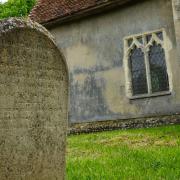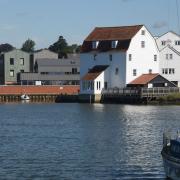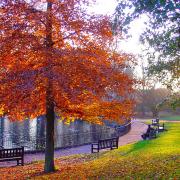Lindsay Want’s indulges in tucked away stuff that’s simply oh-so-Suffolk

For a county with no natural stone to its name, Suffolk is surprisingly flush when it comes to decorative stonework, particularly on its churches. Take a look at the mighty remaining plinth and buttresses of ruined St Andrew’s at Covehithe, Pettistree’s St Peter and St Paul near Woodbridge, Horringer St Leonard’s by Ickworth House, or Gipping’s charming Chapel of St Nicholas near Stowmarket.
The dark flint and limestone chequerboard patterns are awesome, each local flint-stone skilfully knapped to single flat plane perfection. More than just a medieval trademark, the Victorians kept local flint-knappers in business too, but their geometric confections at St Mary Le Tower and St Lawrence in Ipswich are so much more showy than even the flushwork mosaic of heraldic shields on Butley Priory’s 14th century gatehouse.
At Barsham near Beccles, the chequered pattern on the east end of Holy Trinity church is decidedly ‘on the huh’. This 16th century lattice echoes the local lord’s coat of arms, but was possibly conceived as a strengthening device. Perhaps it took inspiration from the Tudor trend for ‘diaper-work’, grey brick diamond patterns used to embellish redbrick houses like Helmingham Hall. The Barsham lattice is almost unique – just down the road, St Peter’s in Spexhall possibly copied the idea using brick.

Sign of the times
Ever stepped into an unassuming or isolated Suffolk church to be greeted by a mosaic of massive diamond-shaped heraldic paintings, all clustered up by the altar end or affirming their authority from the walls of the nave? Pop into the All Saints’ at Easton, or at Sudbourne near Orford and be prepared to be impressed.
Designed to boast the achievements of deceased landowners, ‘hatchments’ are little personal histories, originally hung outside the family home, before being stashed away in the manorial church for safekeeping and /or as a reminder of who was boss! Restored in 2010, Sudbourne’s historic crop are bright and bombastic, relating numerous overseas connections; at Easton the Rochfords, Hamiltons and Wingfields celebrate their status with swathes of gold and smart mythical beasts. Some Suffolk churches such as Kedington near Haverhill have hatchments nestling proudly between the nave arches, but in others these often dark and all-too-imposing paintings might have been given a new home… behind the organ perhaps?

What’s black and white,
or red all over?
From Gazeley’s 400-year-old inn to Great Blakenham’s up-to-the-minute mobile bar service, Suffolk still has a handful of hostelries sporting the time-honoured name, The Chequers. At Eriswell near Lakenheath, you’ll find the chequerboard and pint on the village sign and can’t help wondering whether there’s some subconscious link between the ‘local’ and nearby Roman finds.
The origin of The Chequers as a pub name is hardly black and white. Did the chequerboard come over with the Romans? Was it an abacus of sorts, with inns displaying it as a sign of their banking or ‘exchequer’ services? Perhaps it simply has heraldic significance, reflecting the coat of arms of the local lord? Or is all this barking up the wrong tree?
The Chequers at Kettleburgh surely offers a more Suffolk solution. Its sign shows the deep red overripe fruit of the wild service or ‘chequer’ tree (Sorbus torminalis), once used to flavour beer before hops were introduced. Both fruit and tree bark have a check pattern and ‘Chequer’ orchards were likely to have been commonplace in the Deben valley.
Museum must-sees
Feeling a bit bored, but don’t fancy moving out of the armchair? Orford’s fab little virtual museum is just a few clicks away at www.orfordmuseum.org.uk.
Where better to start checking things out than Cabinet 3, with its two 1000-year-old, Viking gaming pieces made of lead and bronze. There are six cases of fascinating finds to zoom in on and explore, including Roman brooches, a medieval mirror, even a Mesolithic arrowhead; coins, clasps and lots of artefacts great and small which reveal the life and times of the town, river and castle. If your armchair experience gives you a taste for an outing, see these and many more exhibits for real in Orford’s fine castle (open weekends until end March; times /admission prices at www.english-heritage.org.uk ).
Pew with a view
Numerous things will catch your eye in Long Melford – countless shops and antique warehouses, a three-eared rabbit church window, two stately homes… but take a moment to sit in the quiet of the Lady Chapel and – at least to begin with – things just don’t seem to add up.
Attached to the parish church yet, unusually for a Lady Chapel, with no abbey for miles around, it’s a big and solid sort of room, a homely resting place even, where medieval stone pillars separate a wide walkway around a central sanctuary. The altar backdrop is ultra-modern art in breathy bright Suffolk sky blues, quite uplifting for a down-to-earth space where you could imagine yourself sitting comfortably in the wings and enjoying a chin-wag over coffee.
And just as the feel-good factors are multiplying, so a wall full of figures makes everything add up. These are real disciples of discipline and learning – the numbers of a times-table chart, left over from the centuries when the ‘chapel’ was a school room.
Like so many of Suffolk’s intriguing, time-honoured buildings, Long Melford’s Lady Chapel has a wonderfully chequered history, evolving from would-be chantry chapel to school room and much loved community space.




